U.S. Livestock & Meat Trade Update – Jun ’16
Executive Summary
U.S. livestock and meat trade figures provided by USDA were recently updated with values spanning through Apr ’16. Highlights from the updated report include:
• Net pork trade declined on a YOY basis for the second time in the past three months during Apr ’16, finishing 12.4% below the previous year’s record seasonal high.
• Net beef & veal trade remained negative for the fourth consecutive month during Apr ’16, despite import volumes declining on a YOY basis for the seventh consecutive month.
• Net broiler trade remained lower on a YOY basis for the 11th time in the past 12 months during Apr ’16, finishing 5.9% below the previous year.
Additional Report Details
Pork – Net Trade Finishes Lower on a YOY Basis for the Second Time in Three Months
According to USDA, Apr ’16 U.S. pork export volumes increased 1.6% MOM on a daily average basis but finished 11.1% below the previous year’s record seasonal high. Of the major export destinations, YOY declines in export volumes were led by shipments to South Korea (-46.2%), Japan (-28.4%) and Mexico (-5.9%). The YOY declines in shipments to South Korea, Japan and Mexico more than offset YOY increases in U.S. pork exports volumes destined to Hong Kong, Taiwan and China (+86.9%) and Canada (+5.1%). U.S. pork export volumes destined to the aforementioned countries accounted for over 85% of all pork export volumes during Apr ’16.
U.S. pork import volumes declined on a YOY basis for the second consecutive month during Apr ’16, finishing down 4.8%. The YOY decline in pork imports was not enough to offset the decline in export volumes, resulting in Apr ’16 U.S. net pork trade finishing 12.4% below the record seasonal high experienced during the previous year. The YOY decline in net pork trade was the largest experienced in the past 13 months on a percentage basis. ’14-’15 annual net pork trade finished down 10.0% to a new five year low, however, despite the most recent decline, ’15-’16 net pork trade remains up 5.0% YOY throughout the first seven months of the production season.
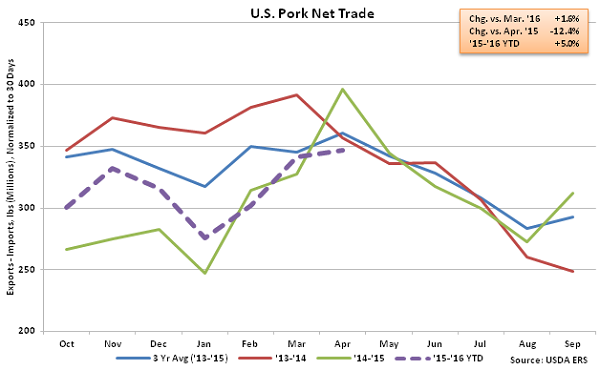 U.S. pork export volumes have strengthened considerably over the past 25 years, increasing at a compound annual growth rate (CAGR) of 13.2%, while U.S. pork imports have remained fairly flat, increasing at a CAGR of 0.3% over the same time period. ’13-’14 annual pork imports experienced much stronger growth, finishing 10.5% higher than the previous year, the largest YOY percentage gain in 11 years. Despite the increase in pork imports, ’13-’14 annual pork exports volumes remained over five times as large as import volumes. Pork export volumes remained over four times as large as import volumes throughout the ’14-’15 production season, despite declining to a five year low on an absolute basis.
U.S. pork export volumes have strengthened considerably over the past 25 years, increasing at a compound annual growth rate (CAGR) of 13.2%, while U.S. pork imports have remained fairly flat, increasing at a CAGR of 0.3% over the same time period. ’13-’14 annual pork imports experienced much stronger growth, finishing 10.5% higher than the previous year, the largest YOY percentage gain in 11 years. Despite the increase in pork imports, ’13-’14 annual pork exports volumes remained over five times as large as import volumes. Pork export volumes remained over four times as large as import volumes throughout the ’14-’15 production season, despite declining to a five year low on an absolute basis.
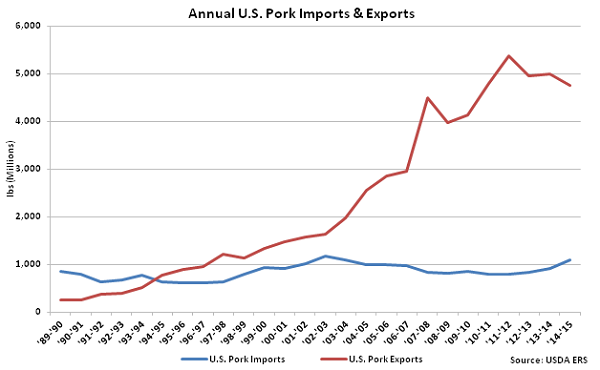 Beef & Veal – Net Trade Remains Negative for the Fourth Consecutive Month
According to USDA, Apr ’16 U.S. beef & veal export volumes remained lower on a YOY basis for the 16th time in the past 18 months, finishing down 5.3%. Of the major export destinations, YOY declines in export volumes were led by combined shipments destined to Hong Kong, Taiwan and China (-22.7%), followed by shipments destined to Japan (-10.9%), Canada (-6.8%) and South Korea (-0.1%). Export volumes destined to Mexico increased on a YOY basis for the second consecutive month, however, finishing up 32.9%. U.S. beef & veal export volumes destined to the aforementioned countries accounted for over 85% of all beef & veal export volumes during Apr ’16.
Apr ’16 U.S. beef & veal import volumes remained lower on a YOY basis for the seventh consecutive month, finishing down 21.2%. Despite YOY declines in beef & veal import volumes, Apr ’16 net beef & veal trade remained negative for the fourth consecutive month as U.S. beef & veal import volumes continued to exceed export volumes.
Beef & Veal – Net Trade Remains Negative for the Fourth Consecutive Month
According to USDA, Apr ’16 U.S. beef & veal export volumes remained lower on a YOY basis for the 16th time in the past 18 months, finishing down 5.3%. Of the major export destinations, YOY declines in export volumes were led by combined shipments destined to Hong Kong, Taiwan and China (-22.7%), followed by shipments destined to Japan (-10.9%), Canada (-6.8%) and South Korea (-0.1%). Export volumes destined to Mexico increased on a YOY basis for the second consecutive month, however, finishing up 32.9%. U.S. beef & veal export volumes destined to the aforementioned countries accounted for over 85% of all beef & veal export volumes during Apr ’16.
Apr ’16 U.S. beef & veal import volumes remained lower on a YOY basis for the seventh consecutive month, finishing down 21.2%. Despite YOY declines in beef & veal import volumes, Apr ’16 net beef & veal trade remained negative for the fourth consecutive month as U.S. beef & veal import volumes continued to exceed export volumes.
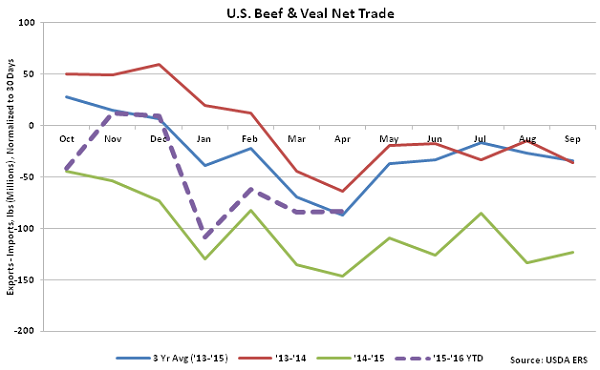 ’13-’14 annual U.S. beef & veal imports finished higher than annual U.S. beef & veal exports for the first time in four years. This trend continued into the ’14-’15 production season as annual imports increased to a ten year high and beef & veal net trade declined to an eight year low.
’13-’14 annual U.S. beef & veal imports finished higher than annual U.S. beef & veal exports for the first time in four years. This trend continued into the ’14-’15 production season as annual imports increased to a ten year high and beef & veal net trade declined to an eight year low.
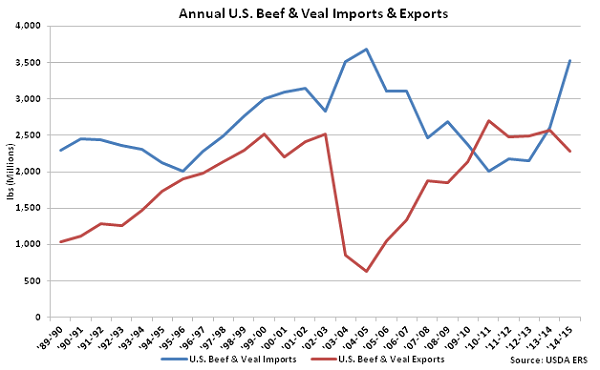 Chicken –Net Broiler Trade Declines on a YOY Basis for the 11th Time in the Past 12 Months
Apr ’16 U.S. broiler export volumes increased 3.2% MOM on a daily average basis but remained lower on a YOY basis, finishing 5.6% below the previous year. Broiler export volumes have declined on a YOY basis over 11 of the past 12 months through April. YOY declines in broiler export volumes were widespread across major export destinations, led by shipments to Canada (-27.6%), combined shipments to Hong Kong, Taiwan and China (-5.3%) and shipments to Mexico (-2.5%).
U.S. broiler import volumes increased on a YOY basis for the 12th consecutive month during Apr ’16, finishing up 14.7%, however import volumes remain at insignificant levels relative to export volumes, with Apr ’16 imports amounting to only 1.7% of export volumes. YOY declines in broiler export volumes, coupled with YOY increases in broiler import volumes, resulting in U.S. broiler net trade finishing 5.9% lower YOY. Net broiler trade declined 10.9% throughout the ’14-’15 production season and is down an additional 10.3% throughout the first seven months of the ’15-’16 production season.
Chicken –Net Broiler Trade Declines on a YOY Basis for the 11th Time in the Past 12 Months
Apr ’16 U.S. broiler export volumes increased 3.2% MOM on a daily average basis but remained lower on a YOY basis, finishing 5.6% below the previous year. Broiler export volumes have declined on a YOY basis over 11 of the past 12 months through April. YOY declines in broiler export volumes were widespread across major export destinations, led by shipments to Canada (-27.6%), combined shipments to Hong Kong, Taiwan and China (-5.3%) and shipments to Mexico (-2.5%).
U.S. broiler import volumes increased on a YOY basis for the 12th consecutive month during Apr ’16, finishing up 14.7%, however import volumes remain at insignificant levels relative to export volumes, with Apr ’16 imports amounting to only 1.7% of export volumes. YOY declines in broiler export volumes, coupled with YOY increases in broiler import volumes, resulting in U.S. broiler net trade finishing 5.9% lower YOY. Net broiler trade declined 10.9% throughout the ’14-’15 production season and is down an additional 10.3% throughout the first seven months of the ’15-’16 production season.
 U.S. broiler export volumes have strengthened considerably over the past 25 years, increasing at a CAGR of 18.3%. U.S. broiler import volumes have increased at a CAGR of 21.6% over the same time period but remain significantly lower than export volumes on an absolute basis. ’13-’14 annual broiler exports volumes were over 60 times as large as import volumes. Broiler export volumes remained 54 times as large as import volumes throughout the ’14-’15 production season despite declining to a five year low on an absolute basis.
U.S. broiler export volumes have strengthened considerably over the past 25 years, increasing at a CAGR of 18.3%. U.S. broiler import volumes have increased at a CAGR of 21.6% over the same time period but remain significantly lower than export volumes on an absolute basis. ’13-’14 annual broiler exports volumes were over 60 times as large as import volumes. Broiler export volumes remained 54 times as large as import volumes throughout the ’14-’15 production season despite declining to a five year low on an absolute basis.
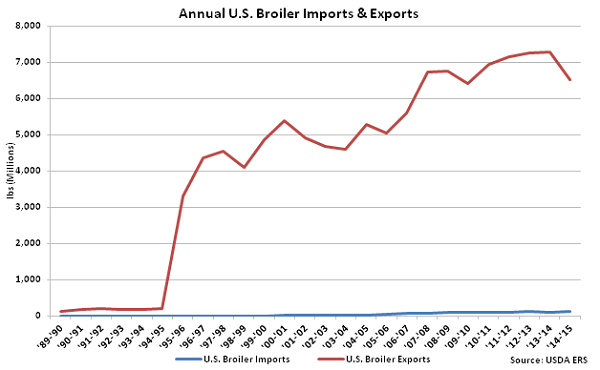 Combined net trade of U.S. pork, beef and broilers declined on a YOY basis for the first time in six months during Apr ’16 as declines in the net trade of pork and broilers more than offset an increase in beef net trade. Combined net trade of pork, beef and broilers had declined for 19 consecutive months from Apr ’14 – Oct ’15 and finished down 21.4% YOY throughout the ’14-’15 production season.
Combined net trade of U.S. pork, beef and broilers declined on a YOY basis for the first time in six months during Apr ’16 as declines in the net trade of pork and broilers more than offset an increase in beef net trade. Combined net trade of pork, beef and broilers had declined for 19 consecutive months from Apr ’14 – Oct ’15 and finished down 21.4% YOY throughout the ’14-’15 production season.
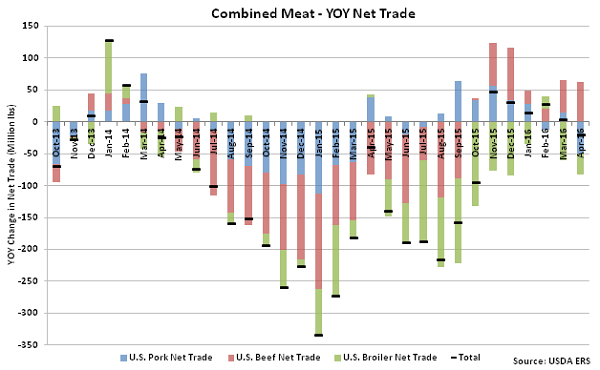
 U.S. pork export volumes have strengthened considerably over the past 25 years, increasing at a compound annual growth rate (CAGR) of 13.2%, while U.S. pork imports have remained fairly flat, increasing at a CAGR of 0.3% over the same time period. ’13-’14 annual pork imports experienced much stronger growth, finishing 10.5% higher than the previous year, the largest YOY percentage gain in 11 years. Despite the increase in pork imports, ’13-’14 annual pork exports volumes remained over five times as large as import volumes. Pork export volumes remained over four times as large as import volumes throughout the ’14-’15 production season, despite declining to a five year low on an absolute basis.
U.S. pork export volumes have strengthened considerably over the past 25 years, increasing at a compound annual growth rate (CAGR) of 13.2%, while U.S. pork imports have remained fairly flat, increasing at a CAGR of 0.3% over the same time period. ’13-’14 annual pork imports experienced much stronger growth, finishing 10.5% higher than the previous year, the largest YOY percentage gain in 11 years. Despite the increase in pork imports, ’13-’14 annual pork exports volumes remained over five times as large as import volumes. Pork export volumes remained over four times as large as import volumes throughout the ’14-’15 production season, despite declining to a five year low on an absolute basis.
 Beef & Veal – Net Trade Remains Negative for the Fourth Consecutive Month
According to USDA, Apr ’16 U.S. beef & veal export volumes remained lower on a YOY basis for the 16th time in the past 18 months, finishing down 5.3%. Of the major export destinations, YOY declines in export volumes were led by combined shipments destined to Hong Kong, Taiwan and China (-22.7%), followed by shipments destined to Japan (-10.9%), Canada (-6.8%) and South Korea (-0.1%). Export volumes destined to Mexico increased on a YOY basis for the second consecutive month, however, finishing up 32.9%. U.S. beef & veal export volumes destined to the aforementioned countries accounted for over 85% of all beef & veal export volumes during Apr ’16.
Apr ’16 U.S. beef & veal import volumes remained lower on a YOY basis for the seventh consecutive month, finishing down 21.2%. Despite YOY declines in beef & veal import volumes, Apr ’16 net beef & veal trade remained negative for the fourth consecutive month as U.S. beef & veal import volumes continued to exceed export volumes.
Beef & Veal – Net Trade Remains Negative for the Fourth Consecutive Month
According to USDA, Apr ’16 U.S. beef & veal export volumes remained lower on a YOY basis for the 16th time in the past 18 months, finishing down 5.3%. Of the major export destinations, YOY declines in export volumes were led by combined shipments destined to Hong Kong, Taiwan and China (-22.7%), followed by shipments destined to Japan (-10.9%), Canada (-6.8%) and South Korea (-0.1%). Export volumes destined to Mexico increased on a YOY basis for the second consecutive month, however, finishing up 32.9%. U.S. beef & veal export volumes destined to the aforementioned countries accounted for over 85% of all beef & veal export volumes during Apr ’16.
Apr ’16 U.S. beef & veal import volumes remained lower on a YOY basis for the seventh consecutive month, finishing down 21.2%. Despite YOY declines in beef & veal import volumes, Apr ’16 net beef & veal trade remained negative for the fourth consecutive month as U.S. beef & veal import volumes continued to exceed export volumes.
 ’13-’14 annual U.S. beef & veal imports finished higher than annual U.S. beef & veal exports for the first time in four years. This trend continued into the ’14-’15 production season as annual imports increased to a ten year high and beef & veal net trade declined to an eight year low.
’13-’14 annual U.S. beef & veal imports finished higher than annual U.S. beef & veal exports for the first time in four years. This trend continued into the ’14-’15 production season as annual imports increased to a ten year high and beef & veal net trade declined to an eight year low.
 Chicken –Net Broiler Trade Declines on a YOY Basis for the 11th Time in the Past 12 Months
Apr ’16 U.S. broiler export volumes increased 3.2% MOM on a daily average basis but remained lower on a YOY basis, finishing 5.6% below the previous year. Broiler export volumes have declined on a YOY basis over 11 of the past 12 months through April. YOY declines in broiler export volumes were widespread across major export destinations, led by shipments to Canada (-27.6%), combined shipments to Hong Kong, Taiwan and China (-5.3%) and shipments to Mexico (-2.5%).
U.S. broiler import volumes increased on a YOY basis for the 12th consecutive month during Apr ’16, finishing up 14.7%, however import volumes remain at insignificant levels relative to export volumes, with Apr ’16 imports amounting to only 1.7% of export volumes. YOY declines in broiler export volumes, coupled with YOY increases in broiler import volumes, resulting in U.S. broiler net trade finishing 5.9% lower YOY. Net broiler trade declined 10.9% throughout the ’14-’15 production season and is down an additional 10.3% throughout the first seven months of the ’15-’16 production season.
Chicken –Net Broiler Trade Declines on a YOY Basis for the 11th Time in the Past 12 Months
Apr ’16 U.S. broiler export volumes increased 3.2% MOM on a daily average basis but remained lower on a YOY basis, finishing 5.6% below the previous year. Broiler export volumes have declined on a YOY basis over 11 of the past 12 months through April. YOY declines in broiler export volumes were widespread across major export destinations, led by shipments to Canada (-27.6%), combined shipments to Hong Kong, Taiwan and China (-5.3%) and shipments to Mexico (-2.5%).
U.S. broiler import volumes increased on a YOY basis for the 12th consecutive month during Apr ’16, finishing up 14.7%, however import volumes remain at insignificant levels relative to export volumes, with Apr ’16 imports amounting to only 1.7% of export volumes. YOY declines in broiler export volumes, coupled with YOY increases in broiler import volumes, resulting in U.S. broiler net trade finishing 5.9% lower YOY. Net broiler trade declined 10.9% throughout the ’14-’15 production season and is down an additional 10.3% throughout the first seven months of the ’15-’16 production season.
 U.S. broiler export volumes have strengthened considerably over the past 25 years, increasing at a CAGR of 18.3%. U.S. broiler import volumes have increased at a CAGR of 21.6% over the same time period but remain significantly lower than export volumes on an absolute basis. ’13-’14 annual broiler exports volumes were over 60 times as large as import volumes. Broiler export volumes remained 54 times as large as import volumes throughout the ’14-’15 production season despite declining to a five year low on an absolute basis.
U.S. broiler export volumes have strengthened considerably over the past 25 years, increasing at a CAGR of 18.3%. U.S. broiler import volumes have increased at a CAGR of 21.6% over the same time period but remain significantly lower than export volumes on an absolute basis. ’13-’14 annual broiler exports volumes were over 60 times as large as import volumes. Broiler export volumes remained 54 times as large as import volumes throughout the ’14-’15 production season despite declining to a five year low on an absolute basis.
 Combined net trade of U.S. pork, beef and broilers declined on a YOY basis for the first time in six months during Apr ’16 as declines in the net trade of pork and broilers more than offset an increase in beef net trade. Combined net trade of pork, beef and broilers had declined for 19 consecutive months from Apr ’14 – Oct ’15 and finished down 21.4% YOY throughout the ’14-’15 production season.
Combined net trade of U.S. pork, beef and broilers declined on a YOY basis for the first time in six months during Apr ’16 as declines in the net trade of pork and broilers more than offset an increase in beef net trade. Combined net trade of pork, beef and broilers had declined for 19 consecutive months from Apr ’14 – Oct ’15 and finished down 21.4% YOY throughout the ’14-’15 production season.
